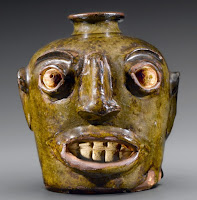
Crude and ugly, wonderfully frightening, the face, or ugly jug, is an iconic form of Black American folk art. It developed in the slave cultures of North/South Carolina and Georgia around the late 1850s. The origin is unclear, however, many reasons have been put forward to explain the mid-19th century appearance of this particular ceramic in the Southeast region of the United States. There are no known extant examples of American face jugs that date to the 18th or early 19th century. Black slaves might have produced them during an earlier period, but there is no solid evidence.
One theory is this distinct art form descended from the
English toby jug. Appearing in the
mid-18th century, the toby jug is a ceramic pitcher based on a number of popular
English caricatures, both male and female.
The jug portrays these characters in full-length sitting positions with
very pronounced, expressive facial attributes and 18th century garb. They were generally used in taverns to serve up
beverages. Theoretically, at some point
in the late 18th or early to mid 19th century, a toby jug made its way into
Africa and was rudely copied by Black artisans who subsequently were enslaved
in the American South and continued to craft their version. Conversely, it could also be said that Black
slaves here in America saw a toby jug and tried to emulate it. Either way, this hypothesis makes little
sense considering the vast difference in appearance, and does not take into
account the possibility of direct African cultural/religious influences.[1]
18th-Century English Toby Jug
The sudden abundance of face jugs in America might be
attributable to the arrival of the last true African slaves. Both the slave ships Wanderer and Clotilda
delivered their human cargo to the United States illegally in 1858 and 1860
respectively, unloading and selling the human contraband in Georgia. While not a complete explanation, it's likely
that some of these slaves ended up making pottery in South Carolina's Edgefield
District, which incidentally, is not far from the Georgia border. One of two major centers in the American
South that had large-scale pottery works, this particular area of the South had
a tremendous need for slave labor to dig clay, make the pottery and tend the
firing furnaces.
American Toby Jug c.1840s
There is precedent for the face jug being a derivative of the indigenous nkisi pottery figurine. Nkisi describes a spirit or the container in which a spirit is captured. The owner can then use the powers of the spirit trapped within the container, provided they have successfully lured and secured it the vessel. Perhaps these newly arrived and enslaved Africans found a way to blend their indigenous religious beliefs within their newly forced trade.[2]
Nkisi from the Congo Region of Africa
There is also something similar from American Indian culture as well. Head pots are found in Northeastern Arkansas and the Southeast corner of Missouri. They have a very similar feel to the 19th-century American face jug. They have only been discovered in this relatively small region, are exceedingly rare, and date to the late Mississippian Period, roughly 100 to 300 years prior to the mid-1800s.
Mississippian Head Pot c.1400-1700 AD
Looking at the archaeological evidence from the Miles Mill pottery works, located within the District, there is an abundance of broken face jug pottery sherds. These show similarity with known Edgefield face jug examples, so it's very possible this region of South Carolina mass-produced face jugs for commercial purposes, in addition to what was being produced by the slaves for their own personal use.
There is much speculation as to what face jugs were used for. One theory says they were for religious purposes,
Black slaves using the jug to ward off evil spirits (no pun intended). Given that face jugs share commonalities with
African religious nkisi figurines,
that is entirely possible. According to
an ex-slave owner who was interviewed in the early part of the 20th century, slaves
made and used the jugs essentially as canteens, so they would have water
available in the fields while they worked.
They called them "monkey jugs". The term was not pejorative, but a description
of all drinking water jugs and supposedly came from the term "monkeyed”, a
term used in the South to describe dehydration.[3]
Towards the end of the 19th century White potters began
making face jugs as well, copying the style that had become popular throughout
the United States. As the 20th century dawned,
face jugs became a novelty, falling into the realm of folk art, practiced only by
a handful of artists. Revitalized
mid-century, this art form continues today with face jugs that tend to
mimic the features of originals, such as the use of simple home made glazes
along with contemporary progressive artists creating completely original works
that deviate from what we think of as traditional. Whatever it's original purpose, the face jug has
come around full circle. It's gone from an
object with common everyday/religious uses, to a true work of art.
*****
1. Newell, Mark M. Making
Faces: Archaeological Evidence of African-American Face Jug Production. Ceramics
In America, 2006. Web. 27 October 2015. http://www.chipstone.org
2. Ibid.
3. Barber, Edwin
Atlee. The Pottery and Porcelain of the United States; An Historical
Review of American Ceramic Art from the Earliest Times to the Present. G.P.
Putnam's Sons, 1901. p.466










